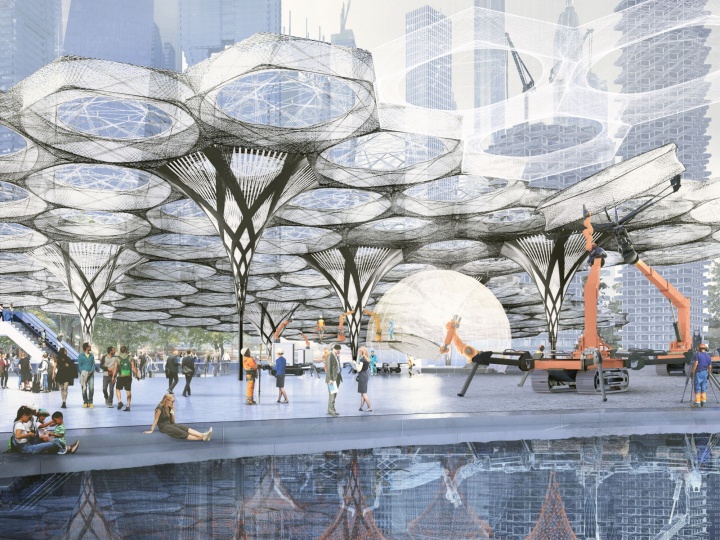Great news for the University of Stuttgart – two Clusters of Excellence, for which the university has applied for a grant as part of the excellence strategy to strengthen top-level research in Germany, have been awarded funding for the next seven years. This was announced today by the German Research Foundation at the meeting of the Excellence Commission in Bonn. The successful clusters are “Data-integrated simulation sciences” and “Integrative Computational Design and Construction for Architecture“. This is accompanied by several million euros per year.
A happy Prof. Wolfram Ressel, Rector at the University of Stuttgart, comments: “The success of not one but two clusters, up against extremely stiff competition, is testament to the successful development of the collaborative research of the University of Stuttgart as well as the expertise established in the past few years in the fields of simulation technology and architecture and adaptive construction. Spurred on by this success, and with the strategic focus of our research profile being on ‘Intelligent systems for a sustainable society’, we are now increasing our efforts in the competition to be awarded the title of ‘University of Excellence’. I would like to thank all the scientists as well as everybody else involved in the application process for all the passion and commitment they have shown.”
The Cluster of Excellence “Data-Integrated Simulation Sciences”: Simulation in the Era of Data Science
Spokesperson: Prof. Thomas Ertl, Institute for Visualization and Interactive Systems and the University of Stuttgart Visualization Research Center, e-mail, Tel. +49 (0)711 685 88331
The Cluster of Excellence “Data-Integrated Simulation Science” targets a new class of modeling and computational methods based on all the data, which is currently available from various sources, in order to take the usability and precision of the simulations as well as the reliability of the decisions based upon them to a whole new level.
Simulations have become an indispensable part of research and development in many different areas, and they make key contributions towards technological progress. Since 2007, the “Simulation Technology” (SimTech) Cluster of Excellence at the University of Stuttgart has advanced simulation sciences in great depth and breadth based on models, methods and computing aspects from an engineering perspective. With its interdisciplinary and methodical profile, it has established itself as an internationally visible research focus. The University of Stuttgart can now advance these findings and successes of its research into a new direction.
“With data-integrated simulation we are introducing a new paradigm into simulation science at the University of Stuttgart”, explains Prof. Thomas Ertl, spokesperson for the Cluster of Excellence. “We are reaching the limits of our traditional approaches, when it comes to simulating highly complex phenomena, for example in environmental issues, in digital human models, and in new materials, and we can only overcome these issues by integrating all the data which is available. We are convinced that the new methods emerging out of SimTech will fundamentally change research and development in many scientific disciplines.”
A variety of forward-thinking research questions
The Cluster of Excellence “Data-Integrated Simulation Sciences” addresses a multitude of forward-thinking research questions. The amount of data available today from sensor readings, data collections, experiments and simulations offers new and increasingly more significant opportunities to gain insights. However, methods purely based on data analysis are often difficult to understand and might not take physical principles into consideration. An in-depth understanding of complex systems can only be gained based on scientific principles.
More precise simulations and more reliable decisions
This is the reason why the scientists want to systematically integrate data extracted from various sources into the modeling-simulation-analysis cycle. The research goal is a new class of both simulation and data-driven approaches, which take the utility and precision of the simulations as well as the reliability of the decisions based upon them to a whole new level. The focus here will be on simulating multiphase flows, porous materials, mechanical structures and biological systems, but also on overarching aspects of machine learning, uncertainty quantification, and ubiquitous IT infrastructures.
The Cluster of Excellence “Integrative Computational Design and Construction for Architecture”: A new way of thinking for the built environment
Spokesperson: Prof. Achim Menges, University of Stuttgart, Institute for Computational Design and Construction, e-mail, Tel +49 (0) 711 685 827 86
The Cluster of Excellence “Integrative Computational Design and Construction for Architecture” aims to harness the full potential of digital technologies in order to rethink design and construction, and enable groundbreaking innovations for the building sector through a systematic, holistic and integrative computational approach.
New buildings will need to be constructed for an additional 2.6 billion people worldwide over the next 35 years. Yet the productivity of the building industry has been stagnating for decades, and even today construction accounts for more than 40 percent of the world’s resource and energy consumption. New approaches for design and construction are urgently required. Digital technologies make it possible to address these challenges in novel ways. However, their adoption is very slow and typically only focused on isolated aspects of the building process due to the fragmented nature of the building industry and a compartmentalised research culture. The cluster of excellence aims to rethink design and construction based on a integrative computational approach. Cluster spokesman Prof. Achim Menges, Head of the Institute for Computational Design and Construction at the University of Stuttgart, speaking about the aims of the cluster, says “Architecture is of central importance for our society. However, the building sector faces enormous ecological, economic and social challenges. We aim to harness the full potential of digital technologies through an integrative and interdisciplinary research approach, in order to create the methodological foundations for groundbreaking innovations and sustainable, future design and construction.”
A key objective is the development of an overarching methodology of the “co-design” of methods, processes and systems, based on interdisciplinary research between the areas of architecture, structural engineering, building physics, engineering geodesy, manufacturing and systems engineering, computer science and robotics, humanities and social sciences. The Cluster aims to push the use of digital technologies in the building sector beyond the mere optimization of established processes and systems towards new, game-changing approaches for computational design, robotic construction and related building systems.
The scientists expect comprehensive approaches to utilising digital technologies that will help address the ecological, economic and social challenges, which current incremental approaches cannot solve.. They aim to create the conditions for a high-quality, livable and sustainable built environment as well as for a digital building culture. Likewise, they want to increase Germany’s competitiveness in the biggest industrial sector in the world. Here they can draw upon the many years of experience that the University of Stuttgart has as a pioneer in architecture and civil engineering, as well as its international profile. The results of the DFG Collaborative Research Centre CRC 1244 in particular (Adaptive Shells and Structures for the Built Environment of Tomorrow, spokesperson Prof. Werner Sobek), as well as the discontinued transregional Collaborative Research Centre CRC -TR 141 (Designing and Construction Principles in Biology and Architecture, spokesperson Prof. Jan Knippers), are incorporated into future research.



